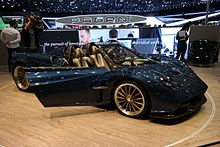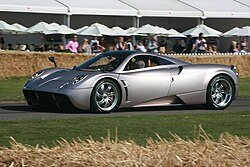Pagani Huayra
| Pagani | |
|---|---|
|
Pagani Huayra (since 2012)
|
|
| Huayra | |
| Production period: | since 2012 |
| Class : | Sports car |
| Body versions : | Coupé , roadster |
| Engines: |
Gasoline engine : 6.0 liters (537-590 kW) |
| Length: | 4605 mm |
| Width: | 2036 mm |
| Height: | 1169 mm |
| Wheelbase : | 2795 mm |
| Empty weight : | 1218-1350 kg |
| Previous model | Pagani Zonda |

The Pagani Huayra is a super sports car that has been manufactured in Modena by the Italian sports car manufacturer Pagani since 2011 . The focus during development was on making the two-seater as light as possible.
production
Like its predecessor, the Zonda , the Huayra is entirely handcrafted. It takes about a month to manufacture a vehicle. By the beginning of 2013, 15 vehicles had been delivered to customers. The last coupé model went into production in April 2018.
body
The body of the Huayra consists of a CFRP titanium monocoque . At the front and rear of the body there are two automatically adjustable downforce aids that are supposed to create an aerodynamic balance. The small flaps are operated by control electronics, which, in addition to the speed, yaw rate, lateral acceleration and accelerator pedal position, also include the steering wheel angle.
Roadster
Pagani presented the Huayra Roadster at the 87th Geneva Motor Show 2017 . This is limited to 100 copies, the cars were already sold when the first pictures were published.
Special editions
Pagani has developed several special editions of the Huayra on customer request.
Carbon Edition
Huayra Carbon Edition on display The first special edition was the Pagani Huayra Carbon Edition presented in 2012 together with the White Edition. It has a full carbon body, wheels and interior, hence the "carbon" part of the name. The interior is equipped with red leather upholstery and carbon fiber inserts. The technical data correspond to those of the standard Huayra.
White Edition
Huayra White Edition. The White Edition was presented in 2012 together with the Carbon Edition. The car has a white and black carbon fiber exterior, a white and black interior, and aluminum wheels.
La Monza Lisa
This special edition Huayra called "La Monza Lisa" was built for the well-known car collector Kris Singh. It features tricolor racing stripes and side stripes inspired by the Zonda Revolucion, and a bright red interior with white stitching inspired by a Zonda F Roadster. At the customer's request, Pagani has also redesigned the firewall behind the occupants so that it is made from a mix of matte and glossy carbon fiber to create a visual effect and, if the customer so requests, to transmit more engine vibrations to the carbon fiber seats. La Monza Lisa also has a unique exhaust system and tailor-made turbochargers from Michael Kübler and Mercedes-AMG.
730S "Da Vinci"
Huayra 730S (now known as Da Vinci) on the road The 730S Special Edition was unveiled in February 2015 at the AutoGallery in Beverly Hills. Most of the car's specs are heavily inspired by the Zonda Tricolore. The car was specially built for Alejandro Salomon (aka Salomondrin), a Mexican-American entrepreneur, former film producer and YouTube personality.
The car was later sold to David Lee, a jewelry and watch tycoon and a well-known Ferrari collector, because Salomondrin felt the car failed to meet requirements after his last appearance on the Hyper Five series he hosted. who had other hypercars like the Porsche 918, LaFerrari and the P1. The car was later renamed "Da Vinci" by Lee after his purchase and upgraded with the Tempesta package.
Huayra BC Kingtasma
A red carbon fiber Pagani Huayra BC was shipped to the USA and is referred to as the "Kingtasma" by the owner. The Kingtasma is one of only four Pagani Huayra BC models that are equipped with a roof shovel. It's also the only Huayra BC that comes with a drink holder from the factory. It also features gold carbon fiber crowns on the bottom of the two rear doors. The Huayra BC Kingtasma is owned by an American real estate tycoon on the east coast of the USA. The owner, the same father-son duo, also owns the Pagani Huayra called "The King".
Huayra BC Macchina Volante
The collector Kris Singh had commissioned a special BC called "Macchina Volante" (the flying machine), which was built in 2017 and adorned with additional amounts of blue carbon fiber and some Italian flags. It also has additional rear air intakes and blue calipers.
Pearl
The Huayra pearl presented in May 2016 is a special edition of the Huayra. It features the split rear wing inspired by the Zonda C12 and the roof air scoop inspired by the Zonda Cinque. Like the Carbon Edition and Da Vinci, the car has an exposed carbon fiber body in a dark blue color. It was involved in an accident in Paris in July 2016 but was rebuilt from the factory in 2017 with an improved engine with an output of 1,350 PS (1,332 PS; 993 kW), making it the most powerful Huayra ever made. It can accelerate from 0 to 97 km / h in 2.2 seconds and has a claimed top speed of over 380 km / h. It shares many components with the Huayra BC and Zonda R, including the suspension, transmission, top-mounted air intake, and the motorsport-derived carbo-titanium monocoque that reduces weight by 132 kg (291 lb) less than before. The renovation took 24 months.
Dinastia
The Huayra Dinastia was a special edition of three Huayra coupes that were presented to the public in 2016. Horacio Pagani's inspiration for this car came from the Nine-Dragon Wall in China. The original plan was to build and sell three cars, but after October 2016, at the request of customers and after research showing that purple and red belong to the same color family (magenta tones), red was replaced by purple. Each unit also has a specific paint job. The design of the car echoes Horacio's visit, with the paint design of each unit resembling one of the dragons on the wall, and it also has an aerodynamic fin on the back that mostly resembles a dragon's tail.
The paintwork of the cars is:
- Blue carbon paint (Baxia, the water dragon)
- Purple carbon paint (Yazi, the warrior dragon)
- Gold-carbon paint (Chiwen, the protective dragon from fire and rain)
Mechanically, the Dinastia is identical to the normal Pagani Huayra. However, Pagani added a lighter titanium exhaust system, new 21-inch forged aluminum alloy wheels, a new front splitter and winglets, deeper side skirts, and an additional tail fin.
Hermes Edition
Introduced in 2016, the Huayra Hermès Edition is a special edition of Huayra owned by Iranian-American millionaire Manny Khoshbin. It includes the Tempesta package as well as a coffee brown exposed carbon fiber body and matching caramel leather interior, designed by Hermès and handcrafted and sewn in the Paris factory. Other changes include a custom Hermès gear knob, inlet grilles with a laser-cut "H" pattern reminiscent of the logo, and a set of matching Huayra luggage bags.
L'Ultimo
The L'Ultimo is the last Huayra coupe to be built for a customer in the USA. It has the same mechanical components as a normal Huayra coupe, but has many bespoke parts that are unique to the car, such as the Pacchetto Tempesta aerodynamic package, a Zonda R inspired roof scoop and a bespoke rear wing. The paintwork, which was inspired by the F1 car of Formula 1 driver Lewis Hamilton, is also unique. The interior also contrasts with the exterior color and has white leather seats with turquoise floor mats and a center console.
Imola
The Imola, named after the famous Italian racetrack, is a special variant of the Huayra with aggressive aerodynamic parts. The Imola was presented at a private ceremony in Switzerland in September 2019 and will be limited to just 5 copies. Imola's first customer is Oleg Egorov, founder and owner of TopCar Design.
The Imola is the most powerful variant of the Huayra to date and uses the same Mercedes-AMG V12 that is set to 827 PS (816 PS; 608 kW) and 1,100 Nm (811 lb⋅ft). Weight-saving measures such as a new carbon fiber mixture and a light application of paint have reduced the dry weight of the Imola to 1,246 kg. Exterior changes from the standard Huayra include a large seven-section diffuser with orange accents, a large roof scoop, a shark fin, more pronounced side skirts and a wider solid rear wing with integrated brake lights
Technical specifications
The vehicle has a twin-turbo V12 engine from Daimler , which AMG produces especially for the Pagani Huayra. It is a variant of the Mercedes-Benz M 275 / M 285 that AMG uses in the 65 models of the S, SL and G-Class. The sequential seven-speed gearbox comes from the British motorsport supplier Xtrac.
| Pagani Huayra | Pagani Huayra BC | Pagani Huayra Roadster | Pagani Huayra Roadster BC | |
|---|---|---|---|---|
| Construction period | 2012-2018 | 2016-2019 | 2017-2019 | since 2019 |
| number of pieces | 100 | 20th | 100 | 40 |
| engine | V12, lengthways at the back | |||
| Valves | 36 | |||
| Displacement | 5980 cc | |||
| Power at 1 / min | 537 kW (730 PS) / 5800 | 588 kW (800 PS) / 6200 | 562 kW (764 hp) / 5500 | 590 kW (802 PS) / 5900 |
| Torque at 1 / min | 1000 Nm / 2250 | 1100 Nm / 4000 | 1000 Nm / 2300-4300 | 1050 Nm / 2000-5600 |
| drive | Rear wheel | |||
| transmission | 7-speed sequential | |||
| Tire v / h | 255/35 ZR 19 / 335/30 ZR 20 | 255/30 ZR 20 / 325/25 ZR 21 | 265/30 ZR 20 / 355/25 ZR 21 | |
| Empty weight | 1350 kg | 1218 kg | 1280 kg | 1250 kg |
| EU standard consumption / 100 km | 15 l super plus | |||
| CO 2 emissions | 343 g / km | |||
| Tank capacity | 100 l | |||
| V max | 360 km / h | 370 km / h | ||
| 0-100 km / h | 3.3 s | 3.0 s | ||
| Base price | 1,061,480 EUR | EUR 2,400,000 | ||
The abbreviation BC stands for Benny Caiola , a Ferrari collector who bought the very first vehicle produced by Pagani in 1999.
Surname
"Huayra Tata" means "father wind" in the Quechua language and was the name of one of their deities.
Web links
- Pagani Huayra on the manufacturer's website
Individual evidence
- ↑ a b Pagani Huayra and Ferrari F12 Berlinetta. auto-motor-und-sport.de, January 26, 2013, accessed April 30, 2013 .
- ↑ Sean Szymkowski: Final Pagani Huayra coupe enters production. In: motorauthority.com. April 11, 2018, accessed December 26, 2019 .
- ↑ Pagani Huayra: This is the successor to the Pagani Zonda. January 26, 2011, accessed April 30, 2013 .
- ↑ Open super sports car approaching. February 15, 2017. Retrieved February 15, 2017 .
- ^ Johannes Wilbert: Mindful of Famine: Religious Climatology of the Warao Indians . Ed .: Harvard University Center for the Study of World Religions. 1996, ISBN 978-0-945454-10-6 , pp. 202 .
